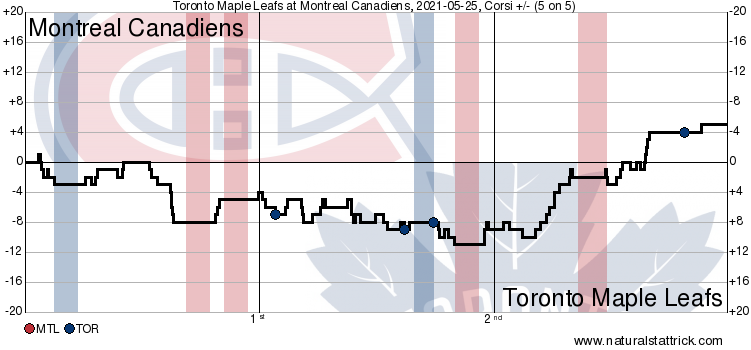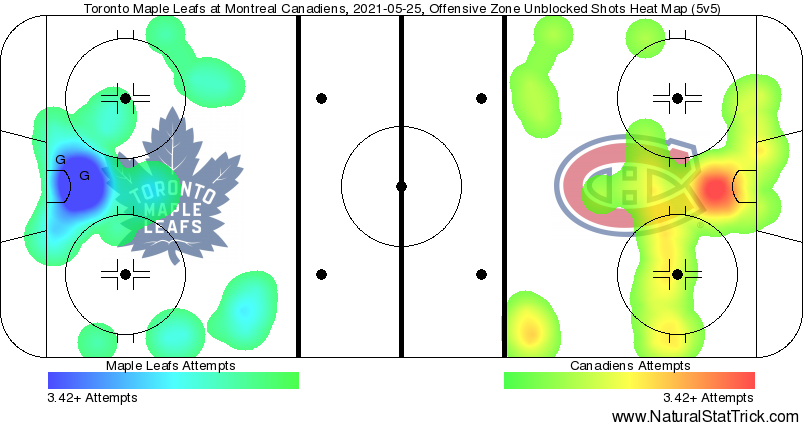Up 2-1 in the series and on the second night of a back-to-back, many were wondering how Sheldon Keefe would approach his lineup decisions in Game 4.
It is understandable if more than a few eyebrows were raised by Rasmus Sandin coming out of the lineup for Travis Dermott, even Riley Nash sitting out, and Adam Brooks making his Leafs playoff debut (messing with a winning formula, etc.)
It did not matter. The Leafs just kept rolling. Now up 3-1, they have a real opportunity heading home to end the series in fairly short order.
Good teams that go deep almost always benefit from one quick series win. If nothing else, it helps you rest and heal up your roster, which is needed in a long playoff run, especially for a team that is already missing John Tavares and Nick Foligno.
Before we get too far ahead of ourselves, your game in 10:
1. The Leafs came out absolutely buzzing in this one, with Jason Spezza getting stopped on a breakaway, followed by Mitch Marner getting turned aside on a 2v1, and the Leafs drawing a power play along the way.
On that power play, the Leafs generated a number of scoring chances, stemming from — of all things — Marner shots. One created a big rebound in front, and there was a shot pass to Matthews for a deflection. Often times, when you come out hot and don’t score, for whatever reason, the other team seems to take the lead shortly after. While things did even out, the Leafs, as has been their MO, simply stuck with it and weren’t particularly rattled by Carey Price standing tall.
The high-danger chances favoured the Leafs 5-1 at 5v5, the score was 0-0, and the Leafs looked completely unfazed by it all.
2. A few years ago, against the Bruins, the Leafs were shorthanded 16 times in the series. The Bruins scored seven power-play goals in that series. The penalty kill almost singlehandedly torpedoed any chance they had of winning it. It’s sort of like goaltending, where you take it for granted (to some degree) when you have it, but when you don’t, it’s a disaster.
The Habs have yet to score a power-play goal in this series. While that could partly be expected — their power play is legitimately bad and has been for years — it still makes life much easier. After the Leafs poured it on to start the first and failed to break through, the Habs had two power plays to close out the period. The best chance on them was a Kerfoot and Marner 2v1.
I mentioned before the series and after Game 3 how the Leafs can be aggressive on the penalty kill thanks to their speed. That speed is causing the Habs fits.
3. Heading into this game, Alex Galchneyuk had not done very much with his opportunity in the playoffs. He played 11:46 in his first game, and his TOI dipped to 9:23 in his second game. He was held shotless and also took a needless four-minute penalty off of a faceoff.
In the first period of Game 4, he notched his first shot on net of the series. In the second period, he came to life with two unreal plays. On the first, he made a behind-the-back to William Nylander right on the tape for a tap-in (after making a true heads-up play to extend his leg out and not go offside). On the second, he feathered a gorgeous backdoor saucer pass to Jason Spezza.
Beautiful pass from Galchenyuk to Spezza. 2-0 Leafs #LeafsForever pic.twitter.com/M5fIK9iooY
— Maple Leafs Hotstove (@LeafsNews) May 26, 2021
Nylander finishes off a beautiful passing play. 1-0 Leafs #LeafsForever pic.twitter.com/9CpoCQZBD7
— Maple Leafs Hotstove (@LeafsNews) May 26, 2021
The Galchenyuk revenge game was in full effect in this one, capped off with an empty netter.
4. We’ve talked about the speed on the penalty kill all series, but it only seems right to note how much it is torching the Habs at 5v5 as well. William Nylander has simply been flying all series — his speed is noticeable every game — and he’s making things happen with it: getting to pucks, catching the Habs and creating turnovers, getting to the dangerous areas, and scoring goals.
Same story with Alex Kerfoot since Game 1. His speed is making things happen, whether it’s intercepting pucks on the penalty kill, winning races to 50/50 pucks, or getting defenders on their heels and backing up off the rush. He recorded two secondary assists on the night, but both were great plays — in particular, the nifty little through pass to Galchenyuk to help create the first goal of the night. That’s an example of where Kerfoot’s speed was cutting through the neutral zone and backing defenders off to create lanes.
On the third goal, Kerfoot did well to find the trailer.
5. The Habs tried going back to their normal formula in this one by playing the Tatar – Danault – Gallagher line along with Chiarot and Weber against the Leafs’ top line. They actually held them scoreless and were ahead of them in shot attempts.
The problem for Montreal is that even without Tavares on the second line, William Nylander is killing them. He has as many goals as their entire team so far this series, and he hasn’t even hit the 17-minute mark in TOI in a single game.
6. In watching the body of work by Pierre Engvall and Ilya Mikheyev — who have been paired together in the regular season and again now in the playoffs — I am not sure you can justify splitting them up (or sitting Engvall). They are two big bodies that use their speed, hound the puck, and cycle. Together, they held the edge in shot-attempt share at 16-13 while drawing most of their ice time against Caufield – Suzuki – Toffoli.
Those aren’t soft minutes. They are responsible, and their speed and size are really standing out. We’ve noted it a bit throughout the series, but I really wanted to take a minute to highlight again that the Leafs are getting good minutes out of those two.
7. The overall defense core on the team goes a little unnoticed on a night like tonight, but they simply did their job. While on the ice with their regular partners, they were all even or better on the shot share at 5v5.
The breakouts were clean and easy. The Habs have to establish a forecheck, zone time, and grind away at the Leafs to have any chance. The defense is making it look so easy that it’s barely being discussed.
They are really nifty at beating forecheckers with shoulder dips and stick fakes, turning the other way, and breaking out with ease. The Leafs love to use the middle of the ice and their centers are circling back deep to present a target, get the puck, and move it out.
Before the third period, the Leafs were out-attempting the Habs 35-26. Heading into this game, chances off of the cycle were 37-11 in favour of the Leafs. The Leafs are simply breaking out and controlling the middle of the ice in their end.
I feel the need here to mention Zach Bogosian as he’s actually quite good at beating the first forechecker and skating the puck out. He helps carry that third pairing to safe minutes consistently.
8. I thought this was a much better third period from the Leafs compared to last night. Obviously, the Habs — down 3-0 in the game and 2-1 in the series — had the advantage in scoring opportunities, but it wasn’t a case of the Leafs getting hemmed in their end for long stretches as it was last night. They did a better job of getting some cycling in, pushing the Habs to the outside a little bit better, forcing dump-ins, and breaking out well when they did.
It was a snoozer of a period if we’re being honest, but entering into it up 3-0, that’s exactly what you want if you’re the Leafs. The Habs had little fight in this one. It was a little stunning to see.
9. The best part of this game for the Leafs might have simply been the lack of ice time for their top guys. You need to have your bottom players feeling like they have roles and skin in the game. Last year against Columbus, the fourth line was barely scratching five minutes at times, but in this game, everyone except Adam Brooks was in double digits and none of Zach Hyman, Mitch Marner, or Auston Matthews cracked the 20-minute mark.
I do not think that has happened in any game this season. It was a full team effort, which is really important at any time (obviously), but especially on a back-to-back. If you’re winning games without your top players carrying you, that is a scary proposition for the opposition.
10. If you’re Montreal, the toughest thing about this 3-1 deficit is that you actually held the Leafs’ top line scoreless, and you still lost handily. In Game 2, the Leafs’ top line and power play got rolling, so you can understand how that one got away from them. In this game? The Leafs’ depth simply won out.
There is a lot more offense on their bottom lines with Pierre Engvall and Alex Galchenyuk inserted since Game 1, and the Habs simply can’t keep up right now. Jack Campbell picked up a shutout, and while he was good in this game, he wasn’t exactly lights out. Add in that the Habs can’t score on the power play to save their lives, and there’s just no real formula for them to win right now unless it’s like a 1-0 or 2-1 game with Carey Price standing on his head.
Now let’s see if the Leafs can take care of business in Game 5. The Jets are waiting.



































